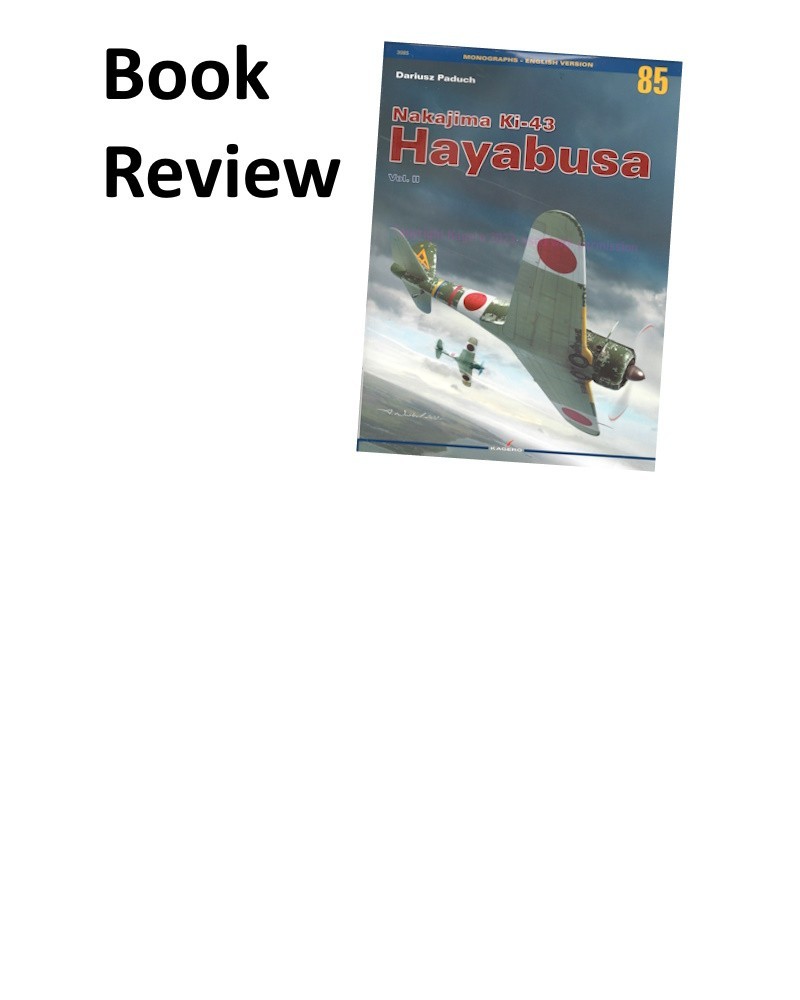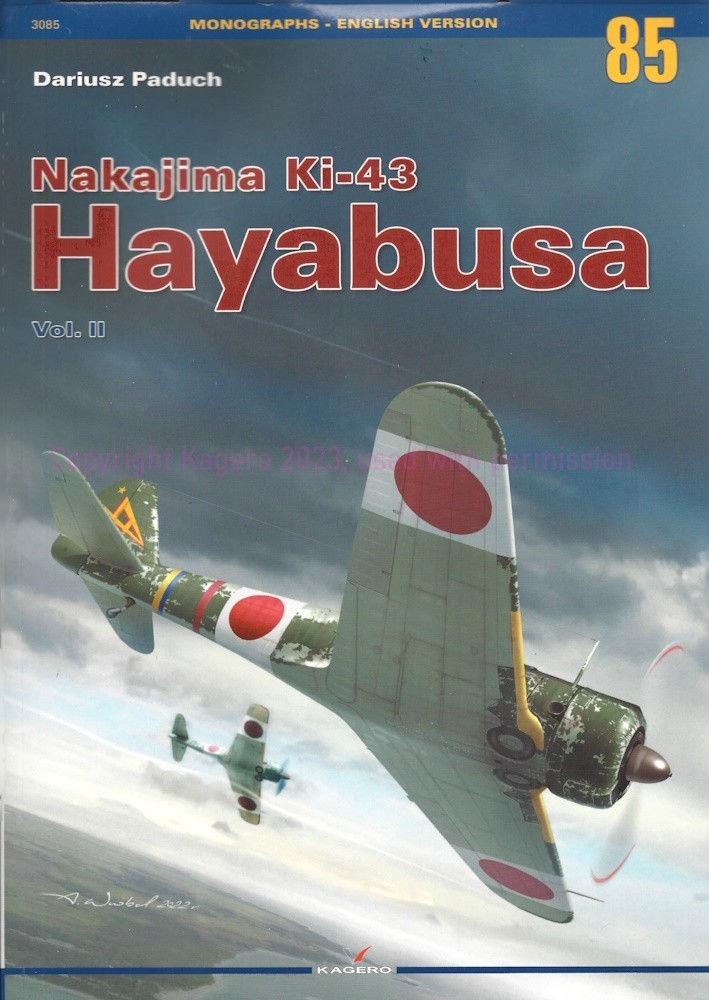
Introduction
Nakajima Ki-43 Hayabusa Volume 2 is the 85th aircraft monograph from Kagero. Authored by Dariusz Paduch, and illustrated by artists Arkaduisz Wr'obel and Zbigniew Kolacha, the book features 80 pages between the covers, and is catalogued with ISBN 978-83-66673-93-9. Casemate Publishers provided this book and as stated on their webpage:
Nakajima K-43 Hayabusa, code-named Oscar by the Allies, was the Imperial Japanese Army’s equivalent of the Zero fighter in service with the Imperial Navy. In combat units the machine replaced the aging Ki-27. Manufactured in large numbers, the fighter remained in frontline service until the end of the war. By the time its final version entered production, the development of its successor – the Ki-84 – had already started. The Ki-43 was a very maneuverable machine, but in many areas it was inferior to its adversaries. Despite its fragile design, poor armament and almost no armored protection, the Ki-43 was well-liked by the Japanese pilots and it became a symbol of the Imperial Japanese Army Air Service.
Regardless, a Hayabusa (Peregrine Falcon) was never a fighter to trifle with, as inferred by Fifth Air Force ace Robert De Haven, who said that 'a well-flown Oscar would leave you talking to yourself.' Indeed, an Oscar - the Allied code name for the Ki-43 - shot down leading P-47 ace and Group Commander Neal Kearby, and a single Ki-43 took on a flight of four P-38s, resulting in the death of Maj. Thomas McGuire Jr., America's second-highest scoring ace. Let us learn of the Ki-43 through this book.
Content
Nakajima Ki-43 Hayabusa Vol. 2 starts out with three-page chapter history of the Organizational Structure of the Imperial Japanese Army Air Service, which presents an informative description of Japanese Army air unit organizations and how they varied during the war. Next is the very short chapter Ki-43 In Combat, which starts with the Ki-43-I arriving at the 59th Sentai in June 1941. It also notes that the first model of Oscar had structural weaknesses resulting in their wings coming off - an inappropriate characteristic for fighter aircraft - and the effort to correct the flaw.
The book seems to mainly draw its text from official reports and histories, although there are a few quotes from aircrew. A particularly interesting account focuses the 50th Sentai's Sergeant Sataoshi Anabuki:
Sergeant Anabuki once again achieved air-to-air victories, this time a Blenheim and a Hurricane. Another Hurricane fell to Anabuki's guns on December 23rd. The following day saw an impressive demonstration of the Japanese pilot’s skills. Anabuki took off in a Ki-43 that had suffered damage in one of the previous raids, with landing gear stuck in an extended position. Unfazed by this minor obstacle, Anabuki took on three Hurricanes and, on his return, reported shooting down shooting all of them down! British records confirmed the loss on that day of two Hurricane Mk.IIbs, one each from 607 and615 squadron RAF, which largely confirms Anabuki's claim. One of those machines exploded just a few meters above the waters of the Irrawaddy River. The pilot was thrown from the cockpit by the force of the explosion, and although severely burned, he fully recovered after some time in hospital.
Malaya and Singapore (December 8th, 1941 to February 15th, 1942) recounts the Oscar’s role in the opening days of the Pacific War. Images include not only Hayabusas, but the aircraft they would escort, as well as the Allied fighters and bombers the Peregrine Falcons preyed upon. This chapter includes some first-hand combat accounts such as that by a Flight Lieutenant Garden:
In front of me I spotted several Japanese single-engine planes, whose pilots didn't notice me and were fooling around over the tops of the clouds practicing mock attacks. When I got closer, I focused on one of them. At this point, the Japanese saw me and entered a tight turn, but I managed to stay behind him and damage his machine with a long burst. The Japanese fighter went straight towards the ground.
The air battles and dogfights are usually not told in great detail, rather giving summaries and mentioning some the units involved, the numbers of aircraft participating, plus claimed kills and actual losses when known. This chapter includes an interesting fact of the common fighter pilot characteristic of misidentifying their opponents, as Buffalo pilots identified radial-engine Oscars as German inline-engine Messerschmitts. This chapter provides interesting trivia, i.e., in a month of fighting the two Sentai lost 14 Oscars in air combat against Brewster Buffaloes and Hawker Hurricanes.
That and the next chapter (28 pages) Dutch East Indies (December 1941- March 1942) presents the Hayabusa in combat . A great deal of air combat occurred over that area and many missions and fights are recounted. The author matches up claims of both sides with admitted losses. One aspect of this chapter very interesting to me is the number of uncommon aircraft engaged by the Oscars. Although we expect to read about Oscars escorting Sallys and Lilys, engaging Hurricanes and Buffaloes, this chapter finds Ki-43 engaging B-17s, Dutch B-10s, Vickers Vildebeests, Dutch-operated Dornier 24s, and Curtiss Demons. While the dogfights are not recounted in blow by blow detail, one can imagine the ferocity of many of these battles. Frequently, not only are the units engaged noted, so are the identities of pilots, and sometimes the aircraft number. The author also notes the movement of Japanese units to various airfields, as well as subsequently to the southeast Asian mainland, which leads us to the next chapter.
Burma (December 1941- August 1945) starts out with a well-known campaign against the American Volunteer Group and Commonwealth units over Burma, China, French Indochina and India. Here we find accounts of yet another uncommon aircraft of the air war, British-flown Curtiss Mohawks, an export variant of the P-36. We also find an event right out of a corny Hollywood B-grade movie that is actually a real event - the last fight of the famous Colonel Kato of the 64th Sentai. Except for some occasional encounters with United States Army Air Force B-17s over the southwest Pacific, over Burma Oscars engaged in a protracted campaign against USAAF B-24 heavy bombers. Over Burma they began to encounter increasing numbers of Spitfires, P-38, P-47 and P-51 fighters, and British Mosquitos. One of these encounters is in first-person by Sgt Anabuki of the 50th Sentai, who recounts his solo attack on B-24s escorted by P-38s, in which he was wounded and yet credited with two P-38 and three B-24 kills:
My mind with obsessed with getting the enemy. My consciousness was nearly fading from the gasoline and the injury, my hand kept on bleeding, and I was out of ammunition. All these negative factors are piling up on me, but all I had in mind was the existence of the powerful enemy in front of me. At that moment I was, by chance, right above the enemy. Although I was out of ammo, reflexes got the better of me and I instinctively put my plane in a dive, presenting an ideal target for the enemy’s rear gunner. I found myself facing a wall of fire, my plane shook as their bullets hit my aircraft. To make matters worse, my engine output went down, and my angle is now so shallow that I was in the bomber's propeller wash and being thrown around wildly. I decided to ram the bomber. “Take this! Yankee!" I pulled up but perhaps my action was too acute, and the next moment, my plane careened into the middle of the fuselage of the third plane on the left side of the formation. I instinctively yanked the stick to evade the crash. The next moment was a tremendous shock hit me with a thunderous roar and I just sat there dumbfounded watching my propeller eating away at the enemy's starboard rudder. There's nothing I could do now. It was as if the plane was being controlled by some gigantic force from outside. The port wing of my aircraft hit the enemy's elevator, which broke off and flew upwards. It all took less than a second, but to me it felt like an eternity. The Americans didn't shoot me because I was too close. I saw them watching the ramming from their turrets and windows.
This chapter also notes Oscars being provided to the air forces of Siam and Burma, with good close-up images of those insignia.
The next chapter is New Guinea, Guadalcanal (December 1942-July 1944), in which Oscars played the major role in the Japanese Army Air Force defense of New Guinea. They even flew some missions in the Solomons, and fought over Rabaul. The next chapter is China (1942 - 1945), a short chapter considering the importance of the theater. Finally, 11 pages wraps up Ki-43's war with the chapters:
· Other Fronts
· Philippines
· Okinawa, 1945
· In Defense of the Home Islands
· Korea
· Foreign Service.
The text is interesting throughout the book. However, there are numerous typos of various sorts. Most of them are uncapitalized proper nouns, and may be explained by translation challenges. There are a few that caused me to stumble in reading, i.e., describing two pilots encountering fighters it states the leader and wingman engaged the fighters; describing the wingman engagement, however, it states,"Initially, also aimed at [the enemy] ...". Punctuation is occasionally questionable. Several pages have a blemish in the same place, obscuring a couple words in sentences. This must have been a printer error as the blemish seems to be the same shape and size on every page it appears on.
Photographs and Artwork
The book is full of good photographs of aircraft, and some pilots. Each photo has useful captions of various lengths. A lot of “there I was” shots, as well as aerial scenes. These photographs are almost all very high quality, and a treasure trove for modelers who want to accurately recreate aircraft markings, camouflage, and weathering. Every photo is in black and white. Several of the photographs are perfect sources for creating dioramas or vignettes.
Photos include a fascinating 64th Sentai Ki-43 sporting a painted fuselage but apparently unpainted wings; the wings look very different than the painted horizontal stabilizers, so the lighter color wings cannot be attributed to sun glare. Another photo clearly shows a Hayabusa painted in European-style segmented camouflage.
Four pages and the back cover display of full color artwork:
1. Nakajima Ki-43-I of the 11th Sentai, Burma, October 1942, the personal aircraft of the unit commander, Major Sughiur. It features the three colors of the various Chutai painted as lightning bolts on the vertical stabilizer, and features a uncommon camouflage pattern. This aircraft is depicted the left side in flight, the right side on the ground, with two overhead planforms, one of which also shows the bottom of the wings juxtaposed on either side of the fuselage.
2. Ki-43-II, 33rd Hiko-Sentai, abandoned at Cyclops airfield, New Guinea
3. Oscar, 54th Sentai, Kurile Islands, 1943
4. Ki-43-II, Nanking 1943, in an overall brown color
5. Mottled brown and green Oscar of the Royal Thai Air Force
6. Oscar I, Indochina, late 1942
7. Oscar, 50th Sentai, Burma, 1942.
That artwork is good as it covers a selection of camouflage and markings.
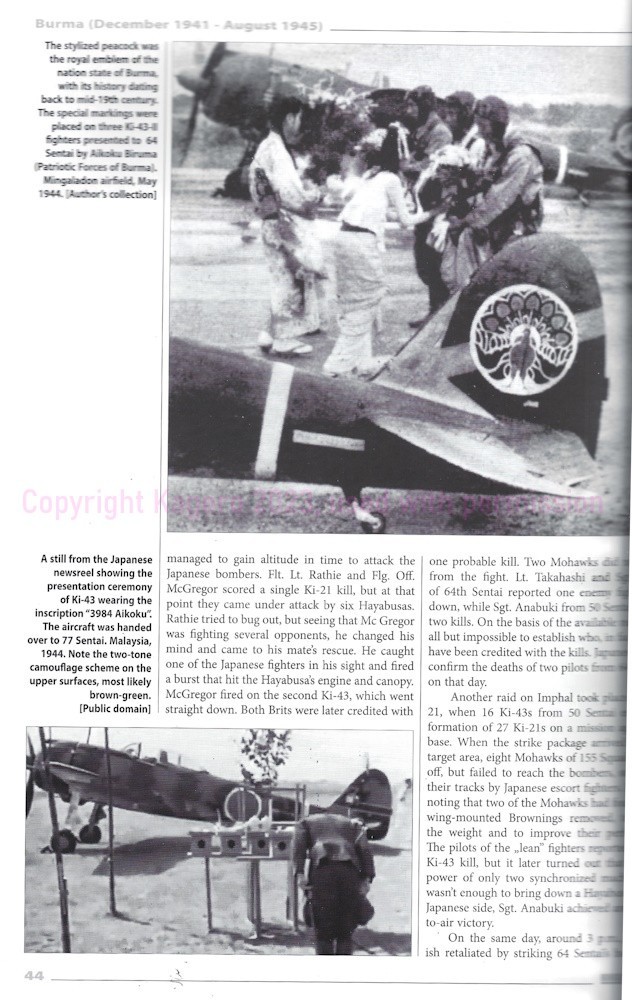
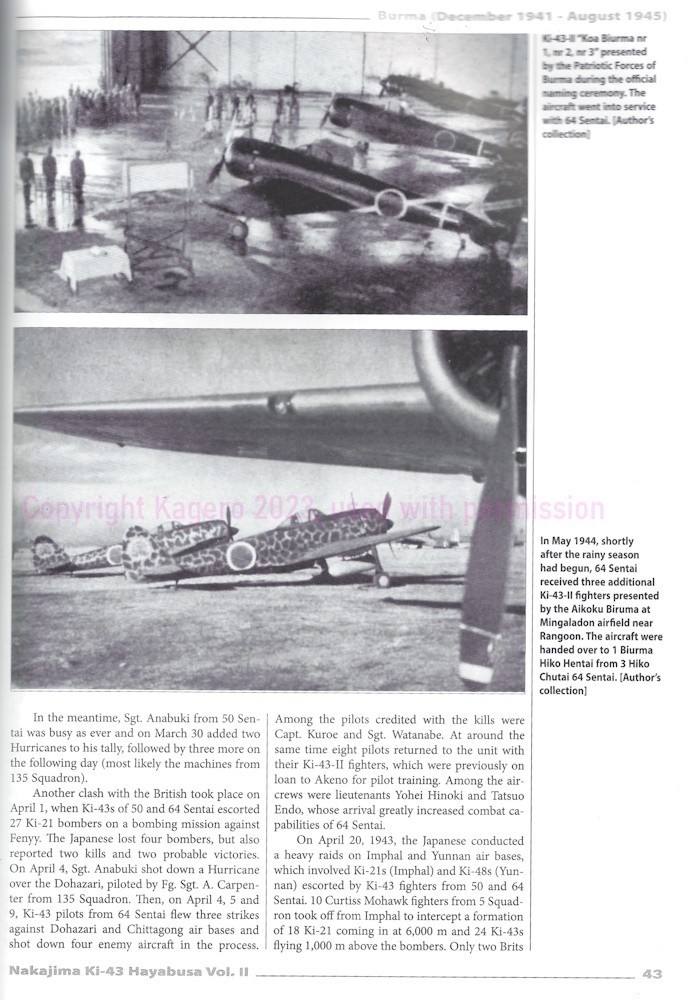
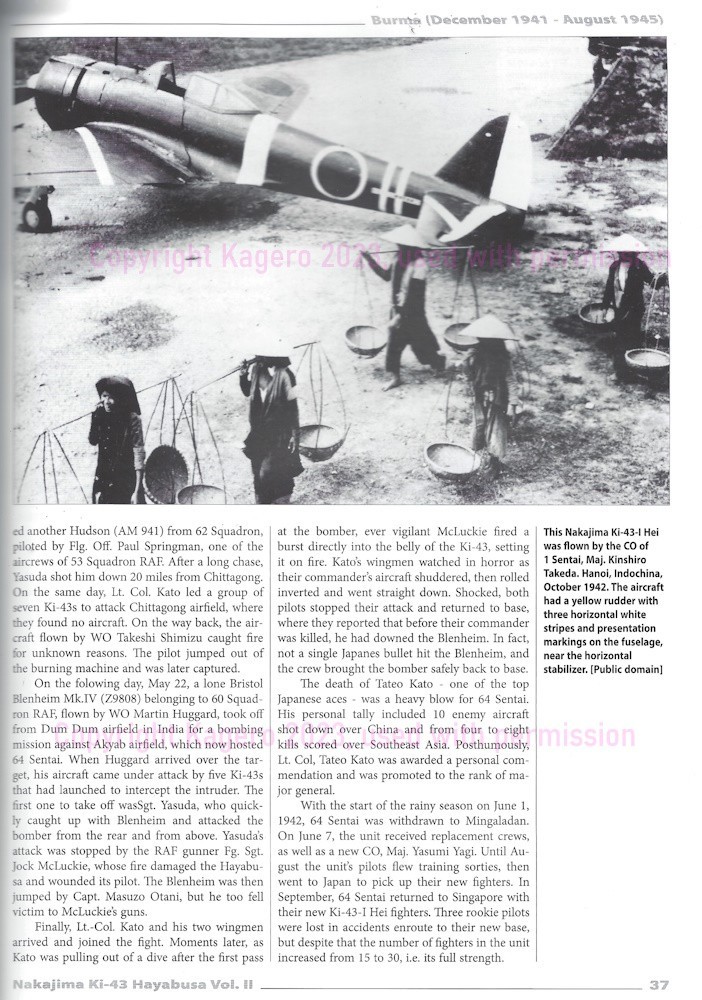

Conclusion
Nakajima Ki-43 Hayabusa, Volume 2, the 85th title of the Kagero monographs, is an exciting and very useful book for enthusiasts, students, modelers of the iconic Oscar. Most of the photographs are clear and all are very useful source material and reference images. Some of them scream for you to model the particular aircraft or build a diorama. The color artwork is good to see as well, as it covers a selection of camouflage and markings.
As for the text, I appreciate that this version is an English translation. I do not consider the author accountable for the numerous typos and printing quality control failures. Overall, the book is readable and the information you can get from it is useful. The numerous typos and syntax errors are annoying, and I expect better from Kagero publications. I mean, they didn't even list the correct book on the title page!
Regardless, I definitely appreciate the exploration of Hayabusas across the Japanese Army Air Force’s expanding and contracting areas of conquest. The photographs and artwork are definitely good for modelers, and the accounts in the texts also present interesting stories to spark the imagination, with varying degrees of detail. Especially the first-hand accounts.
Despite the typos, I do recommend this publication for students and modelers of Nakajima’s Ki-43 Hayabusa.
Please remember to mention to Kagero, Casemate, and retailers that you saw this book here - on Aeroscale.










